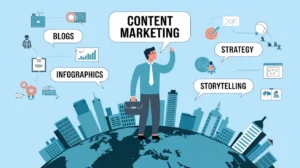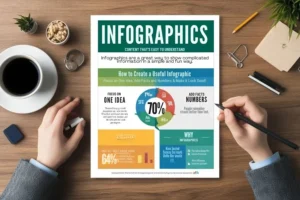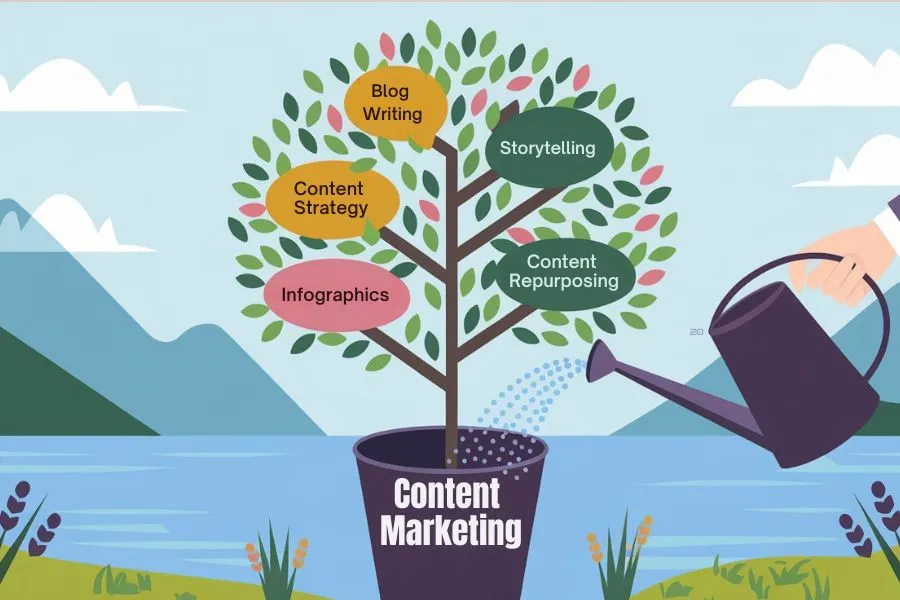Content marketing is one of the best ways to grow your business online. Whether you’re a small business owner, a freelancer, or part of a big team, creating valuable content helps you connect with people and build trust. In this guide, we’ll explore the main parts of content marketing: blog writing, content strategy, infographics, storytelling, and content repurposing.
What is Content Marketing?

Content marketing is about creating useful content that your audience needs. This content could be blog posts, videos, infographics, or anything else that helps your audience solve a problem, learn something new, or make a decision.
Why is Content Marketing Important?
Good content brings people to your website, builds your brand, and increases sales. Studies show that businesses using content marketing can get 6x more leads than businesses that don’t. It also costs less than traditional advertising and delivers better results in the long run.
Blog Writing: The Start of Your Content Journey
Blog writing is one of the easiest ways to start with content marketing. Blogs let you share helpful tips, explain your services, and even answer common customer questions.
How to Write a Blog That Works
- Know Your Readers
Understand who you’re writing for. Think about their questions, problems, and goals. - Use SEO
Add keywords people search for on Google. Use tools like Ubersuggest to find popular topics. - Make It Easy to Read
Use headings, short paragraphs, and lists. Include pictures or videos if they help explain your points.
Example of a Great Blog
A fitness blog that shares simple workout tips for beginners can get a lot of readers. For instance, a post titled “5 Easy Exercises You Can Do at Home” solves a common problem in a relatable way.
Content Strategy: A Plan for Your Content
A content strategy is like a map that guides what you create, why you create it, and how you share it. Without a plan, your content may not reach the right audience.
Steps to Build a Simple Content Strategy
- Set Your Goals
Decide what you want. Are you aiming for more website visitors? More email signups? Know what success looks like. - Pick Topics That Matter
Choose themes your audience cares about. For example, a bakery could create content about “easy baking recipes” or “tips for making perfect cookies.” - Stay Organized
Use a content calendar to plan when and where you’ll publish. Can use below tools:
| Google Calendar | Trello |
- Review and Adjust
Look at how your content is performing. If something isn’t working, change it. Use free tools like Google Analytics to track results.
Infographics: Content That’s Easy to Understand

Infographics are a great way to show complicated information in a simple and fun way. People love visuals, and they are more likely to share infographics than plain text.
How to Create a Useful Infographic
- Focus on One Idea
Infographic is necessary but don’t use it too much. Pick one topic and make it clear. - Add Facts and Numbers
Use real data to back up your points. For example, if you’re talking about social media use, include stats like “70% of adults use Facebook.” - Make It Look Good
Use free design tools like Canva or Piktochart to create professional-looking designs.
Why Infographics Work
People remember visuals better than text. Adding an infographic to your blog or social media post can boost engagement by up to 94%.
Storytelling: Connecting Through Emotions
Stories are the best way to connect with the audience. A good story makes your brand feel real and relatable.
How to Tell a Good Story
- Start Strong
Begin with a hook that grabs attention. For example, “I started with just $500 & a dream” is more engaging than “Let me tell you about my business.” - Be Honest
Share real experiences, successes, or even mistakes. People appreciate authenticity. - Have a Purpose
Every story should teach something, inspire action, or explain your values.
Example of Storytelling
Think about brands like Apple. Their ads don’t just talk about their products—they tell stories about creativity, innovation, and making dreams come true.
Content Repurposing: Use Your Content Again and Again
Content repurposing means taking something you’ve already made and using it in a new way. This saves time and helps you reach more people.
Easy Ways to Repurpose Content
- Turn a Blog into a Video
Take key points from a blog and create a short video for YouTube or Instagram. - Split Infographics into Posts
Break down an infographic into individual images for social media. - Use Quotes for Social Media
Pull inspiring or helpful quotes from a blog or video and turn them into shareable graphics.
Example of Content Repurposing
A long guide on “Healthy Eating Tips” can be broken into smaller pieces like Instagram posts, tweets, or a podcast episode.
Final Thoughts on Content Marketing
Content marketing isn’t about writing as much as you can—it’s about creating useful, interesting content that helps your audience. Whether you’re writing blogs, planning a content strategy, designing infographics, telling stories, or repurposing old content, every piece should serve a purpose.
FAQs
-
What is content marketing?
Content marketing is the process of creating useful content to attract and engage your audience, like blogs, videos, and infographics.
-
How do I start blog writing?
Start by understanding your audience, choosing topics they care about, and writing in a clear, easy-to-read way.
-
What are infographics used for?
Infographics help explain complex ideas in a visual format, making them easier to understand and share.
-
Why is storytelling important?
Storytelling connects with people on an emotional level, making your brand more memorable.
5. Where can I learn more about content strategy?
Check out the Content Marketing Institute for helpful tips and examples.

